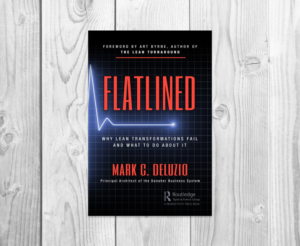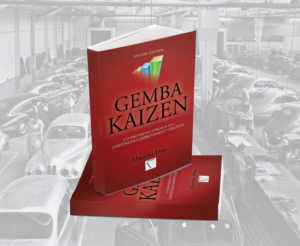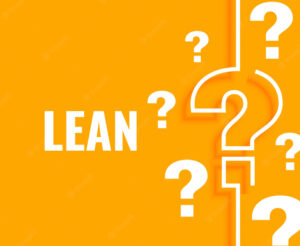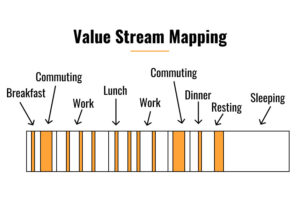Download this executive summary in PDF: Taiichi Ohno’s Workplace Management
CHAPTER 1 The Wise Mend Their Ways
- As a human, we make mistakes. Even the wise man is probably right seven out of ten.
- Correct yourself rapidly when you are wrong. Don’t wait to acknowledge your mistake.
- Having a sense of humility is a condition to persuade others.
CHAPTER 2 If You Are Wrong, Admit It
- We can easily fall for an optical illusion.
- Trying by yourself is a way to be sure you don’t have misconceptions.
- If you see by yourself that you were wrong, admit it, people will be more willing to cooperate.
- Intellectuals who have more ideas in their head are more prone to misconceptions.
CHAPTER 3 Misconceptions Reduce Efficiency
- People think producing one at a time is slower than making many in a row.
- Working diligently does not mean working efficiently.
CHAPTER 4 Confirm Failures with Your Own Eyes
- Instead of debating if an idea is good, just try it and see the results with your own eyes.
- You can see what cause failures and take measure to present them.
CHAPTER 5 Misconceptions Hidden within Common Sense
- Our common sense is maybe not the best way.
- We need to have the awareness that we may have misconceptions.
- Changing thinking may help to find a new path.
CHAPTER 6 The Blind Spot in Mathematical Calculations
- Price – Cost = Profit (the price is set by a third party)
- Profit = Price – Cost (a profit must be made, the seller sets the price accordingly, makes a more value-added product to set a higher price to increase profit)
- Price = Cost + Profit (the customer decides if the price set by the seller as acceptable, the government sets the profit for example)
- These 3 formulas are mathematically the same but have different meanings.
- Costs exist to be reduced, not to be calculated.
CHAPTER 7 Don’t Fear Opportunity Losses
- Forecasting sales is inaccurate, and estimating investment on the forecast is uncertain.
- Opportunity Loss is when there is demand but not enough investment to fulfill it.
- Opportunity Loss is not a real loss while an actual loss causes harm.
- Reducing costs is a viable strategy for reducing loss when there is no growth.
CHAPTER 8 Limited Volume Production Is to Produce at a Low Cost
- Even if sometimes producing more volume can lower the cost, there are still other costs such as moving and storing the extra volume not sold.
- When there is no growth, what is the volume to stay fit?
CHAPTER 9 Reduced Inventory, Increased Work in Process
- Turning raw materials into work in progress is not lean.
- Don’t produce what you don’t need and don’t sell.
- Work in progress in inventory cannot be sold.
- When a machine is idle, it deteriorates less, you don’t use electricity, operators don’t do overtime, and you keep your raw material for a future order.
- By producing more, you think it reduces costs, but in the end, it is a mistake.
CHAPTER 10 The Misconception That Mass Production Is Cheaper
- It is a misconception that low production is expensive.
- Increasing volume production seldom reduces costs.
- Overtime is costly when producing more, and buying another machine worsens the cost of operation.
- When changeover time is reduced, you can produce low volume inexpensively. If the customer believes low volume must be expensive, you can sell the low volume at a higher price.
CHAPTER 11 Wasted Motion Is Not Work
- In Japanese, “to move” and “to work” have the same pronunciation and almost the same character.
- There is a risk of confusing moving with working.
- In a zoo, a monkey moving is “working” while children are watching them because the zoo is making money. But when the monkeys are alone, they are just “moving”.
CHAPTER 12 Agricultural People Like Inventory
- Japanese are descendants of agricultural people, they like to produce as much as possible and stock because they never know when the weather and harvest will be good or not.
- They learned to manage inventory and build warehouses.
- The price of rice is going higher and higher because farmers think that sales price = cost + profit, the more they have costs and keep the profit same, the more they increase the sales price.
- Whether the harvest was good or not, they keep the same price. The price is set by the costs to produce.
CHAPTER 13 Improve Productivity Even with Reduced Volumes
- There was a surplus of rice in Japan, the Japanese government paid farmers to grow reeds instead of rice in the rice paddles.
- However, the volume didn’t decrease because of the gain in productivity per paddle.
- A gain in productivity is easier when there is an increase in volume.
- Increasing productivity with reduced volume during a recession increases the chance of survival.
CHAPTER 14 Do Kaizen When Times Are Good
- Shifting production to a higher value-added product is also a solution to keep your margin.
- Kaizen should be done when the company is profitable to be prepared for an economic downturn.
- Protecting jobs is a priority in Japan, so companies must find other ways to reduce costs.
- Reducing costs by using scientific methods and eliminating waste.
- When in a difficult situation, it is harder to have good ideas.
CHAPTER 15 Just in Time
- Being too early is not good, being late is worse.
- Just in time is not proper English but reflects well its meaning.
- Delivering the parts when there is still one or two hours’ worth of parts available at the line side is “just in time”.
CHAPTER 16 Old Man Sakichi Toyoda’s Jidoka Idea
- Jido: “automation with the human element added”
- Toyoda Automatic Loom Works invented a machine, when the thread broke or ran out, the machine would stop with the device to avoid defective products.
CHAPTER 17 The Goal Was Ten-fold Higher Productivity
- In 1937, on average, there was a difference in the productivity of nine to one between the USA and Japan even if Japan was already using American machines.
- To catch up on productivity, changing the way of thinking was necessary.
- Improving productivity three folds was possible just by leveling out the assembly workload between the 1st and 30th of the month.
- Operators had the misconception of working harder when the factory improved productivity three folds because they confused work with motion. When they were not producing, they were using their time doing other kinds of labor.
CHAPTER 18 The Supermarket System
- Instead of buying what the producer made in parts whether you need it or not, you buy only what you need same as a supermarket.
- Traditional Japanese groceries delivered the food directly at your door, inconvenience is that you must order a minimum quantity and you had the risk that the grocery was out of stock.
- The upstream process only needs to produce as many parts as the downstream process takes away.
CHAPTER 19 Toyota Made the Kanban System Possible
- The challenge of the supermarket system is to make sure the upstream processes can supply downstream processes just in time.
- Kanban system is possible if changeovers are very short and lot sizes small.
- Before the kanban system, the upstream process produced their parts, stocked them in a warehouse, and considered they did their job. A car can be sold only when all the parts are assembled.
- Ohno took almost ten years to deploy the kanban system in the Motomachi plant because he was not in charge of the whole process. Convincing other managers to use kanban was a challenge.
CHAPTER 20 We Learned Forging Changeover at Toyota do Brasil
- At Toyota do Brasil, output was 40 cars per month. Because of this low volume, nobody wanted to supply Toyota do Brasil with forging parts.
- Toyota do Brasil bought one forging equipment, to produce the 60 types of parts, changeovers had to be shortened from one hour to 15 minutes.
- External setup was used to prepare the die ahead of time to speed up the changeover.
- Three persons from Toyota Japan went to Brasil to learn about forging changeover.
- Toyota Motors has a medium volume of 3000-5000 cars/month there are few changeovers.
CHAPTER 21 “Rationalization” Is to Do What Is Rational
- The Ohno System was new, nobody tried it before. If the tests were poor, changes were made right away.
- They were several layers of management, top-down and bottom-up communication was difficult.
- In 1956, Ohno saw his first American automobile factory, there was nothing exceptional, only common sense and rationality.
CHAPTER 22 Shut the Machines Off!
- Making defects is not considered“work”.
- Stopping the machine is necessary to take countermeasures to reduce defects.
- Stopping the line is costly, it forces kaizen to reduce line stoppage.
- Making defects increases cost, so cost is reduced when you reduce defects.
CHAPTER 23 How to Produce at a Lower Cost
- In 1950, it was more rational to buy passenger cars from the USA than from Japan. Productivity and demand were low in Japan.
- The Toyota System is effective when there is a low volume. It is only during the oil shock crisis in 1973 that the Toyota System attracted attention. Toyota remained profitable despite the decrease in volume.
- The Toyota System is to make “what you need, in the amount you need, by the time you need it, at a lower cost”.
CHAPTER 24 Fight the Robot Fad
- Some manufacturers install robots to keep up appearances and to have reduced man-hours.
- Is cost reduced when robots or computer systems are installed?
- Automation should come as a result of a need.
- When there is a high unemployment rate, is installing more robots good for society as a whole?
CHAPTER 25 Work Is a Competition of Wits with Subordinates
- Struggle together and find out solutions together.
- Take care of people who accept to follow you.
CHAPTER 26 There Are No Supervisors at the Administrative Gemba
- The gemba philosophy works also in administration.
- A strong supervisor knows his team and the personality of each member.
- After one year, did productivity increase under the supervision of the supervisor? Did they do the same work with fewer people?
CHAPTER 27 We Can Still Do a Lot More Kaizen
- If you increase your productivity, you can make 120 parts but you need only 100 parts, you should be thinking about how to make 100 parts with fewer people.
- Producing in sets makes the individual parts cost more but the actual product shipped costs less.
- You can sell a product only when the parts of the set are assembled.
- Making too many parts too early are waste.
CHAPTER 28 Wits Don’t Work Until You Feel the Squeeze
- Become more attractive to other people so they will willingly make more effort and follow you.
- Be more present so people will talk to you more frequently and openly.
CHAPTER 29 Become a Reliable Boss
- Scolding a supervisor on the shop floor makes the workers sympathize with him and listen more to him.
- Team leaders should not be changed too often, workers need time to build trust and rely on the team leader.
- While the supervisor is in gemba, he should be busy helping and workers should want to ask for help from you.
CHAPTER 30 Sort, Set in Order, Sweep, Sanitize
- Throw away what is not needed then set in order so it is easy to retrieve an item when required.
- Lining things up is not sorting if retrieving an object is difficult.
- Discipline is necessary so order and cleanness are sustained. In modern, people lack more and more discipline, schools emphasize too much on academics and neglect discipline.
- Parents are too busy working and neglect teaching discipline to their children.
- Veteran athletes teach discipline to other athletes.
CHAPTER 31 There is a Correct Sequence to Kaizen
- Master your current equipment before buying a more modern machine.
- Kaizen should be done in this order: manual work kaizen, equipment kaizen, then process kaizen.
- When you want to do manual work kaizen but the machine is preventing you, buying the right machine will improve your productivity.
- Experience workers who did kaizen on their old machines will rapidly do kaizen on the newly acquired machine. Inexperienced workers using new machines will end up running the workers.
- Quality is built in the process, there is no need to inspect at the end if the product is inspected during each process.
- Manual work kaizen is the most important because it guides the equipment kaizen and the changes needed to be done on process kaizen as a result of changes on equipment kaizen.
- When the machine is working and the operator is watching the machine, the operator is not really working, machine cycle time and manual cycle time are often mixed up.
CHAPTER 32 Operational Availability vs. Rate of Operation
- Operational availability is when your machine is not broken or down because of changeover, you can use it to produce. Operation availability should be maximize
- Rate of operation is when you have been using the machine. There is no need to use the machine if there is no order.
- Maintenance increases operational availability.
CHAPTER 33 The Difference Between Production Engineering and Manufacturing Engineering
- Manufacturing engineers determine the method of manufacturing, production engineers accomplish that method of manufacturing.
- Manufacturing engineers study how to use scissors to cut things, production engineers study what is the right type of scissors for the job.
- Production engineers are often separated from the gemba. They should evaluate the proper equipment and the processes required to make the product.
- Then manufacturing engineers should do equipment kaizen and process kaizen.
CHAPTER 34 The Pitfall of Cost Calculation
- Cost calculation depends on some parameters such as planned volume and sales but they are uncertain.
- If you miss your projection, your purchase of the new equipment may make you lose money.
- When a machine is fully depreciated, it should not be scrapped but used to produce at a low cost.
CHAPTER 35 The Monaka System
- The monaka is a Japanese bread, you can prepare the shell in advance because it doesn’t go bad easily, you just add the sweet red bean filling the day before.
- Likewise, dies in the press are the shell and the core is the sweet bean section.
- A company generates profits by trading, using wisely the money, and reducing costs.
- Cost reduction at the gemba should be done from the beginning. When trading is good, the gemba can take it easy, but when the market is tighter, drastic cost reduction is difficult.
- Work in process and inventory are money that could have been invested in the financial market to get dividends.
CHAPTER 36 Only the Gemba Can Do Cost Reduction
- Cost reduction targets set by accounting are meaningless if there is no actual cost reduction.
- No need to know cost knowledge to be actually reducing cost in the gemba.
- The positive effects of kaizen on cost reduction are accumulative and show results later, it needs perseverance.
CHAPTER 37 Follow the Decisions That Were Made
- Follow the rules that have been set, it is easier said than done.
- If the rules are not followed, it means there is something wrong with the rules, try something new immediately.
- People tend to follow better the rules they set by themselves.
- Kaiaku is a change for the worse. Fix it, don’t come back to your previous state.
- Standard work should be evolving regularly, it is the baseline you compare kaizen with.
CHAPTER 38 The Standard Time Should Be the Shortest Time
- Setting the standard of a repetitive work by measuring the average time is not accurate.
- Toilet time and changeover should not be included in the average time.
- If people cannot do the work within this time, you should teach them to do the work within this time.
Download this executive summary in PDF: Taiichi Ohno’s Workplace Management








